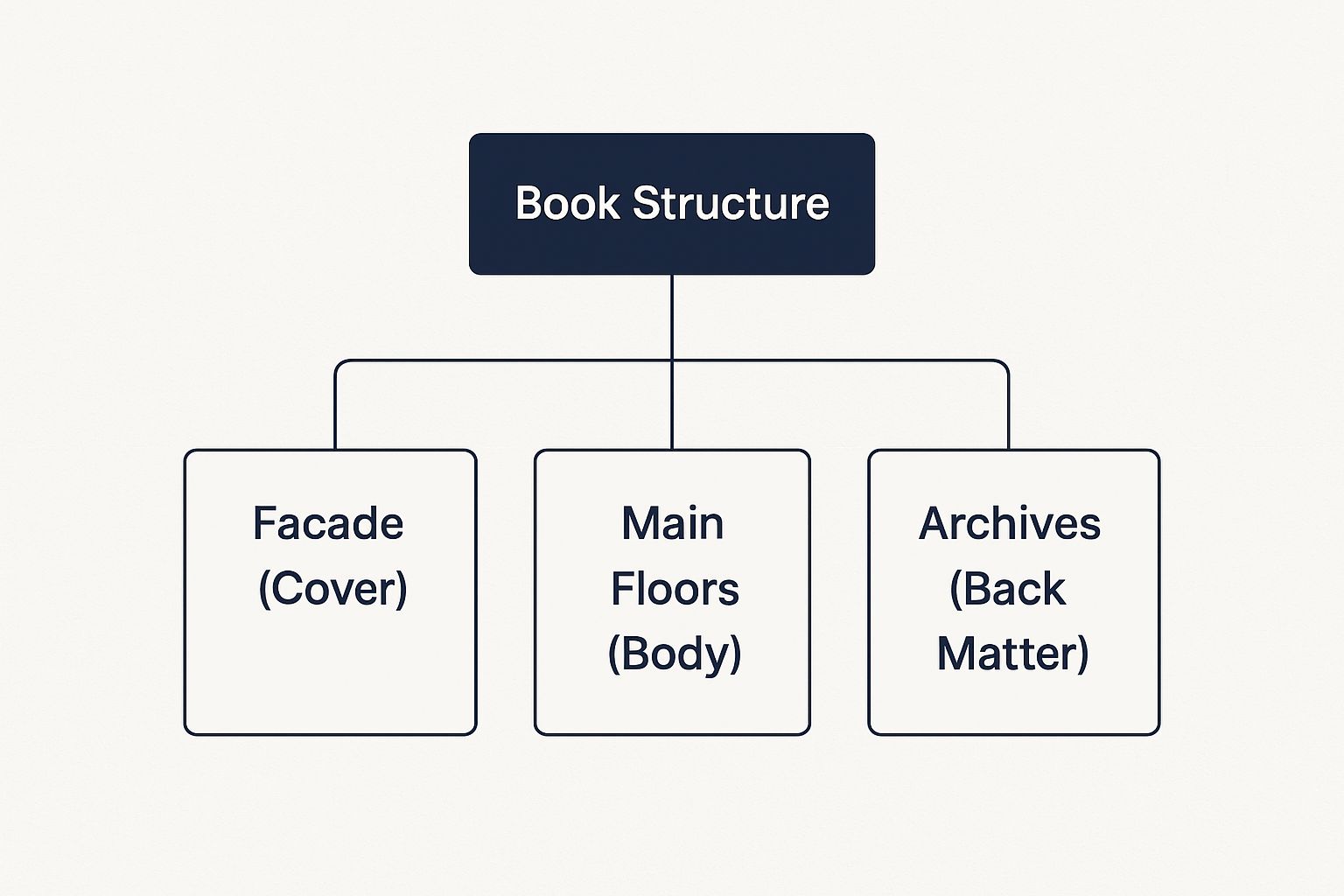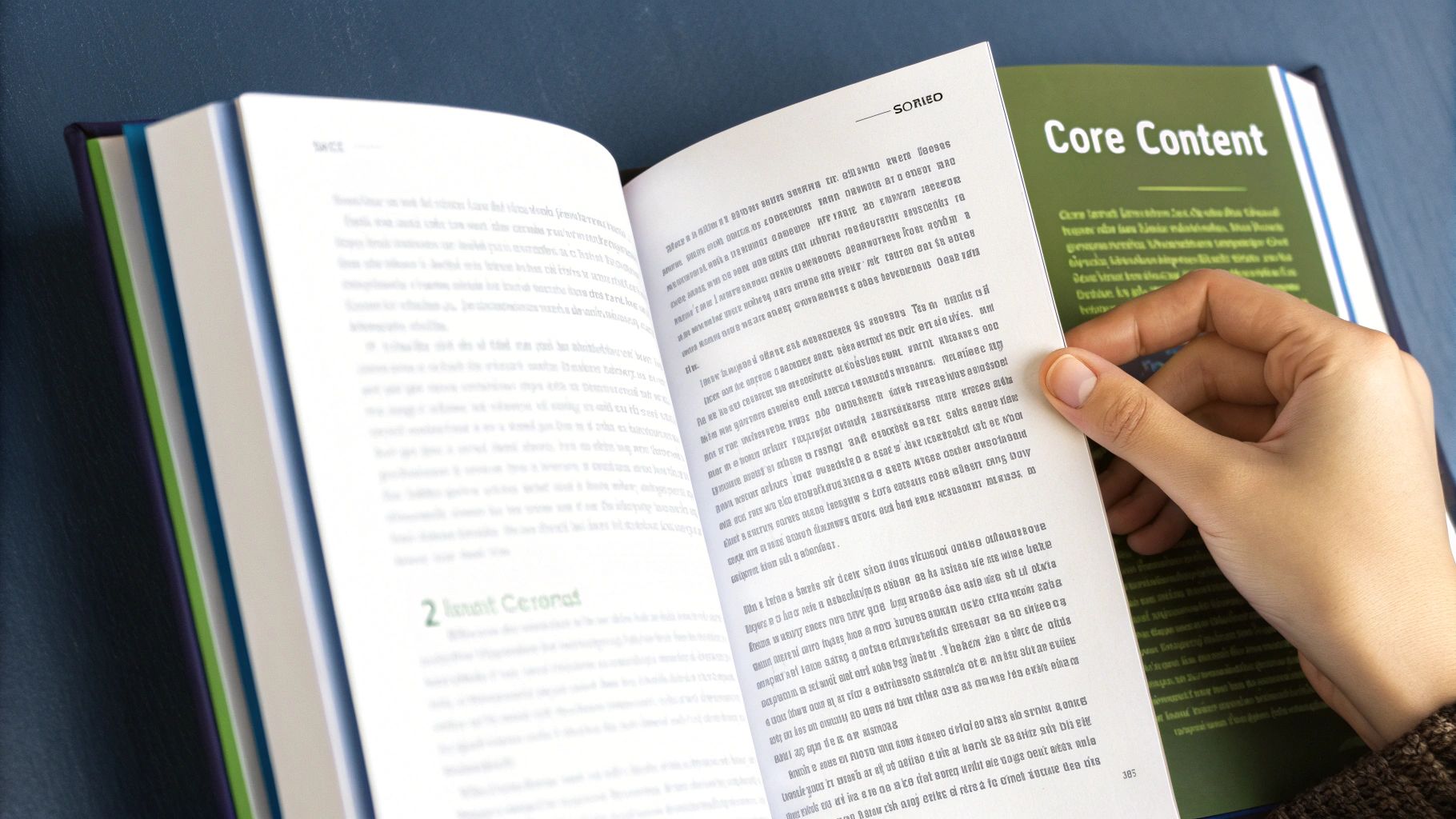Long before you ever get to the first chapter, a book has already started telling its story.Long before you ever get to the first chapter, a book has already started telling its story. It does this through its structure, which is really just a map for the reader.
Think of it this way: every book is built around three core parts. You’ve got the front matter (everything before the main text), the body (the heart of the content), and the back matter (all the extras at the end). Knowing how these pieces fit together is invaluable, whether you’re an avid reader or an aspiring author.
Your Journey Through a Book Begins Here
I like to think of a book's structure like a well-designed building. The cover is the facade that draws you in. The front matter is the lobby—it orients you and tells you what to expect. The body is where you spend most of your time, exploring the different floors and rooms. Finally, the back matter is like the building’s archives or library, filled with extra resources.
Understanding this blueprint doesn't ruin the magic; it actually deepens your appreciation for the craft involved. You start to see the deliberate choices an author and publisher make to guide your experience.
For anyone who dreams of building their own literary world, mastering this structure is non-negotiable. If you're just starting out, a solid guide to writing books for beginners can be a huge help in laying down that foundation, turning a daunting idea into a manageable project.
The Three Core Sections of a Book
At its core, a book’s anatomy is elegantly simple. It's organized into three distinct sections that work in harmony to deliver a complete and satisfying experience.
Let’s quickly break down this fundamental structure. The following table gives you a bird's-eye view of how a book is organized.
| Core Section | Primary Function | Common Components |
|---|---|---|
| Front Matter | Sets the stage and provides context | Title Page, Copyright Page, Dedication, Table of Contents, Foreword |
| The Body | Delivers the main story or information | Chapters, Parts/Sections, Illustrations, Footnotes |
| Back Matter | Offers supplemental resources and closure | Appendix, Glossary, Bibliography, Index, Author's Note |
Each section has a specific job to do, guiding you from the initial "hello" to the final "goodbye" and beyond.
This simple infographic provides a great visual for how these three parts come together.

As you can see, it’s a logical progression. This framework isn’t just about rules; it’s about creating a clear and enjoyable roadmap for anyone who opens the cover.
The Exterior Parts That Make the First Impression
A book’s journey doesn’t start on page one. It begins the moment your eyes land on it, sitting on a shelf or displayed on a table. The exterior parts of a book are its handshake, its first impression, and the armor that protects the story within. These elements are meticulously designed to catch your eye, tell you what the book is all about, and keep those precious pages safe.

Think of a book's exterior as its outfit. Just like a well-tailored suit or a colorful dress can hint at a person's personality, a book's cover, spine, and binding signal its genre, tone, and who it’s for—all before you read a single word. This snap judgment is a huge part of the reading experience.
The All-Important Cover
The cover is, quite simply, the face of the book. It’s a powerful marketing tool that has to do some heavy lifting. In a single glance, it needs to communicate big ideas like genre, mood, and theme. A dark, shadowy cover with sharp, minimalist text might scream "thriller," while a lush, illustrated landscape instantly pulls you into a fantasy world.
A cover is typically made up of a few distinct parts:
- Front Cover: The main event, featuring the title, the author's name, and the core artwork or design.
- Back Cover: This is where you'll find the blurb (that tantalizing summary), glowing reviews from other authors, and the all-important ISBN barcode.
- Flaps (on dust jackets): For hardcovers, these inner folds usually house the author's bio and a slightly longer, more detailed plot summary.
Because it’s so critical, authors and publishers agonize over getting the cover just right. If you're curious about the art and science behind it, these book cover design tips offer a fantastic look into how color, fonts, and imagery work together to hook a reader.
The Spine and The Binding
The spine is the book's backbone. It’s what holds all the pages together, and more importantly, it's what you see when the book is nestled on a bookshelf. That’s why it has to clearly display the title, author, and publisher’s logo—it's the key to being found in a crowded bookstore.
Holding the covers and spine together is the binding, the unsung hero that fastens the pages into a single unit. The binding style has a massive impact on a book’s durability, how it feels in your hands, and its price tag.
The binding is the unsung hero of a book's physical form. It dictates not only how the book opens and feels in your hands but also how long it will last as a treasured object.
You’ll generally run into two main types of binding:
- Case Binding (Hardcover): Think of this as the premium option. Pages are sewn together in little bundles (called signatures) and then glued to a tough, rigid cover, or "case." It’s built to last, which is why it’s the standard for first editions, special editions, and library books.
- Perfect Binding (Paperback): This is the go-to for most paperbacks. All the pages are stacked into a block, and the edges are glued directly to a flexible cardstock cover. It's a much more cost-effective method, perfect for mass-market books that need to be affordable and portable.
Getting Your Bearings: What Comes Before Chapter One
Before you even get to the first chapter, a book has already started talking to you. This opening section is called the front matter, and it’s much more than just a few throwaway pages. Think of it as the opening credits of a movie—it sets the scene, introduces the key players, and gives you the context you need to appreciate what’s coming.
These pages aren't just filler; they're the roadmap. They orient you and prepare you for the journey ahead.

From legal details to a heartfelt dedication, every piece of the front matter has a job to do. Understanding what these pages are for is like knowing the opening moves in chess; it gives you a deeper appreciation for the experience you’re about to have.
The Title and Copyright Pages: The Official Handshake
The first thing you’ll probably see is the half-title page, which usually just has the book's title and nothing else. It’s a quiet opening. Turn the page, and you get the full title page, which is the book’s official introduction. This is where you'll find the complete title, the author’s name, and the publisher. It feels standard now, but this page has a long history, really taking hold after the printing press arrived in the 1440s and becoming a staple by the 16th century.
Right after that is the copyright page. It might look like a wall of dense legal text, but it's full of important information. This is the book's birth certificate.
- Copyright notice: This is the legal "hands-off" sign, showing who owns the work.
- Edition history: It tells you when the book was first published and lists any later printings.
- Publisher information: You'll find the publisher's name and where they're located.
- ISBN (International Standard Book Number): Every book has a unique 13-digit code, like a fingerprint. This is it, and it’s essential for libraries, bookstores, and sellers to track it.
Dedications, Epigraphs, and a Table of Contents
Once the legal stuff is out of the way, the book's personality starts to emerge. You’ll often find a dedication page, which is the author's personal shout-out to someone important in their life. It’s a small, intimate window into the author’s world.
Next up, you might see an epigraph—a short quote, poem, or snippet from another work. The author chooses this carefully to set the mood or hint at a central theme. It’s the literary equivalent of an appetizer before the main course.
And then comes the table of contents, the book's skeleton key. It lays out the entire structure, listing every chapter and its starting page number. This is your go-to guide for navigating the book and quickly finding exactly what you’re looking for.
The front matter is more than just a collection of preliminary pages; it's the book's first conversation with the reader, establishing tone, credibility, and a clear path forward.
Forewords, Prefaces, and Introductions: Setting the Stage
In many books, especially non-fiction, there are a few extra sections designed to frame the main content. People often mix them up, but they each serve a very different purpose.
A foreword is written by someone other than the author. Usually, it’s a respected expert or a public figure who can speak to the book's importance. Their role is to vouch for the book, giving it a stamp of approval from an outside perspective. If you're an author thinking about this, knowing how to write a foreword well is crucial.
The preface, on the other hand, comes directly from the author. This is their chance to talk to you, the reader, about why they wrote the book, what their journey was like, or what they hope you'll get out of it. It’s the "how" and "why" behind the project.
Finally, an introduction dives right into the subject matter. It lays the groundwork for the book’s main arguments, defines key terms, and gives you a preview of the topics you're about to explore.
Diving Into the Heart of the Book: The Body Text
After you’ve flipped past the title page and table of contents, you finally arrive at the main event: the body. This is the substance of the book, the core content where the story breathes, the arguments are built, and the real knowledge is shared. It's the reason you picked up the book in the first place.

Whether it’s a gripping novel or a dense textbook, this central section is never just a wall of text. It's carefully constructed to guide you. A novelist uses chapters to control suspense and pacing, while a non-fiction author uses a logical structure to build understanding step-by-step.
How the Main Text is Built
The body of a book is organized with a clear hierarchy. This isn't just about looking tidy; it's a road map for the reader's journey. Getting this structure right is crucial, and if you're an author, our guide on how to format a book dives much deeper into creating a seamless reading experience.
You'll typically find these building blocks:
- Parts or Sections: Think of these as the major acts in a play. They group together clusters of related chapters. A history book might use a "Part" for each historical era, while a sci-fi saga could dedicate a "Part" to a specific planet or character arc.
- Chapters: These are the fundamental units of a book. Chapters break down the larger narrative into digestible chunks, each focusing on a specific event, idea, or theme. They give the reader natural places to pause and reflect.
- Subheadings: You’ll see these most often in non-fiction. Subheadings are signposts within a chapter that break up complex information, making it easier to scan and absorb.
Tools for Navigating the Journey
To keep readers from getting lost, authors and designers use a few key navigational tools. The most basic and essential is pagination, or simply, page numbers. This is the book's built-in GPS, letting you mark your spot, reference a specific quote, or follow a citation. Interestingly, before the printing press took off in the 16th century, manuscripts often used foliation (numbering the leaves, not the pages). Pagination became the standard because it was far more precise for a world of printed, double-sided pages.
Beyond just finding your page, other tools provide extra context without interrupting the story.
Footnotes and endnotes are like quiet whispers from the author. They add fascinating details, cite sources, or share a quick thought without breaking the spell of the main text.
- Footnotes: You'll find these at the bottom of the page they relate to, offering immediate context for a specific word or idea.
- Endnotes: These are gathered together at the end of a chapter or the entire book. They're less intrusive and perfect for longer asides or a comprehensive list of sources the reader can check out later.
Finally, non-fiction books often bring in visual elements to do some heavy lifting. Block quotes are used to set longer quotations apart from the main text, giving them special emphasis. You'll also see tables and figures, which are fantastic for presenting data or complex relationships in a simple, visual way that makes them easy to understand at a glance.
8. What Comes After the Story? Understanding the Back Matter
Just because you've read the last chapter doesn't mean the book is finished. Now, we flip to the back matter, sometimes called the endmatter. Think of it as the book's bonus material or resource center—a collection of extra content that adds depth and context to the main story.
While you might not find much back matter in a thriller or romance novel, it’s absolutely essential for non-fiction, academic texts, and technical guides. These final pages are what turn a book from a one-time read into a reference tool you'll keep coming back to.
Appendix and Glossary
One of the first things you might find is an appendix. This is where authors stash all the good stuff that didn't quite fit into the main narrative. It’s the perfect spot for things like detailed data tables, original documents, case studies, or long lists that would have otherwise interrupted the book's flow.
Right alongside it, you'll often see a glossary. This is basically a custom-made dictionary just for the book in your hands. If the author uses a lot of industry-specific jargon or technical terms, the glossary gives you quick, simple definitions so you're never left guessing. It ensures everyone is on the same page, no expert knowledge required.
The back matter is what transforms a book from a simple story into a lasting resource. It’s where an author proves their research and invites you to keep learning long after you’ve closed the cover.
Bibliography and Index
Next up is the bibliography, which is a complete list of every source the author leaned on—books, articles, interviews, you name it. This isn't just about giving credit where it's due; a solid bibliography builds a book’s authority. It shows you the author did their homework and even gives you a roadmap to explore the topics further on your own.
Finally, we arrive at the index. An index is an alphabetical list of all the key people, places, and ideas mentioned in the book, with the exact page numbers where you can find them. For anyone doing research or studying a topic, the index is a lifesaver. It lets you jump straight to the information you need without having to skim through hundreds of pages.
Each part of a book—the front matter, the body, and the back matter—is there for a reason. For professional and academic publishing, the back matter is especially critical. Its indexes and bibliographies are what give a book its credibility and make it genuinely useful. Interestingly, as publishing changes, some of this material is shifting to digital supplements to make it even easier for readers to search. To see more of what’s happening in the industry, the Association of American Publishers is a great resource.
Common Questions About the Parts of a Book
As we’ve walked through a book from cover to cover, a few practical questions always seem to pop up. When you understand why each piece exists, the whole structure of a book just clicks. It's not arbitrary; it's a craft refined over centuries.
Let's tackle some of the most common things that trip up new writers and curious readers. Getting these details right matters because they follow conventions that people expect, even if they don't consciously realize it.
Foreword vs. Preface: What's the Difference?
This is easily one of the most common points of confusion. People often use these terms interchangeably, but they serve two very different functions.
A foreword is always written by someone other than the author. Think of it as a guest introduction. It's usually penned by an expert in the field or a well-known figure who can speak to the book's importance. Their job is to lend the book credibility and tell you, from an outside perspective, why this work is worth your time.
The preface, on the other hand, comes directly from the author. This is their chance to speak to you, the reader, before the main journey begins. They might share what sparked the idea for the book, who they wrote it for, or the challenges they faced during the research and writing process.
A simple way to remember it: The foreword is a respected colleague giving you a glowing recommendation. The preface is the author pulling you aside for a quick, personal chat before the show starts.
Do All Books Need an Index?
Definitely not. Whether a book needs an index depends entirely on its purpose.
Indexes are the workhorses of non-fiction, especially academic textbooks, technical manuals, and dense historical accounts. Their job is purely functional: they help you pinpoint specific names, concepts, or topics buried deep within the text. Without one, finding a particular piece of information would be a nightmare.
You’ll almost never see an index in a fiction book. Novels and short story collections are meant to be read from start to finish. The experience is about the narrative flow, so a tool for looking up terms just gets in the way. The rule of thumb is simple: if your reader might ever need to jump back to find something specific, an index is a must-have.
What Is an ISBN and Why Is It So Important?
The ISBN (International Standard Book Number) is a unique 13-digit code that acts like a fingerprint for a specific edition of a book.
That last part is key—the hardcover, paperback, and ebook versions of the very same title will each have their own distinct ISBN. It’s the single most important identifier in the publishing world.
Here’s why it’s non-negotiable for anyone serious about selling their book:
- It’s the key to the supply chain. Booksellers, libraries, and distributors all use the ISBN to order, track, and manage their inventory.
- It makes your book discoverable. The ISBN gets your book listed in global databases, so anyone, anywhere, can find and buy it.
- It tracks your success. All sales data is tied directly to the ISBN, allowing you and your publisher to see how the book is performing.
Basically, without an ISBN, your book doesn't officially exist in the marketplace.
Where Does the Table of Contents Go?
The table of contents always lives in the front matter—the collection of pages at the very beginning of a book. Its placement is quite specific, following a long-established order.
You'll typically find it right after the copyright page and before any other introductory material like a foreword or preface. It’s positioned there for a reason. It acts as a roadmap, giving the reader a bird's-eye view of what’s to come and helping them get oriented before they dive in.
At BarkerBooks, we guide authors through every one of these structural decisions, ensuring each part of your book is professionally formatted for a global audience. From securing your ISBN to designing the perfect interior layout, we handle the details so you can focus on your story. Learn more about our publishing services.
